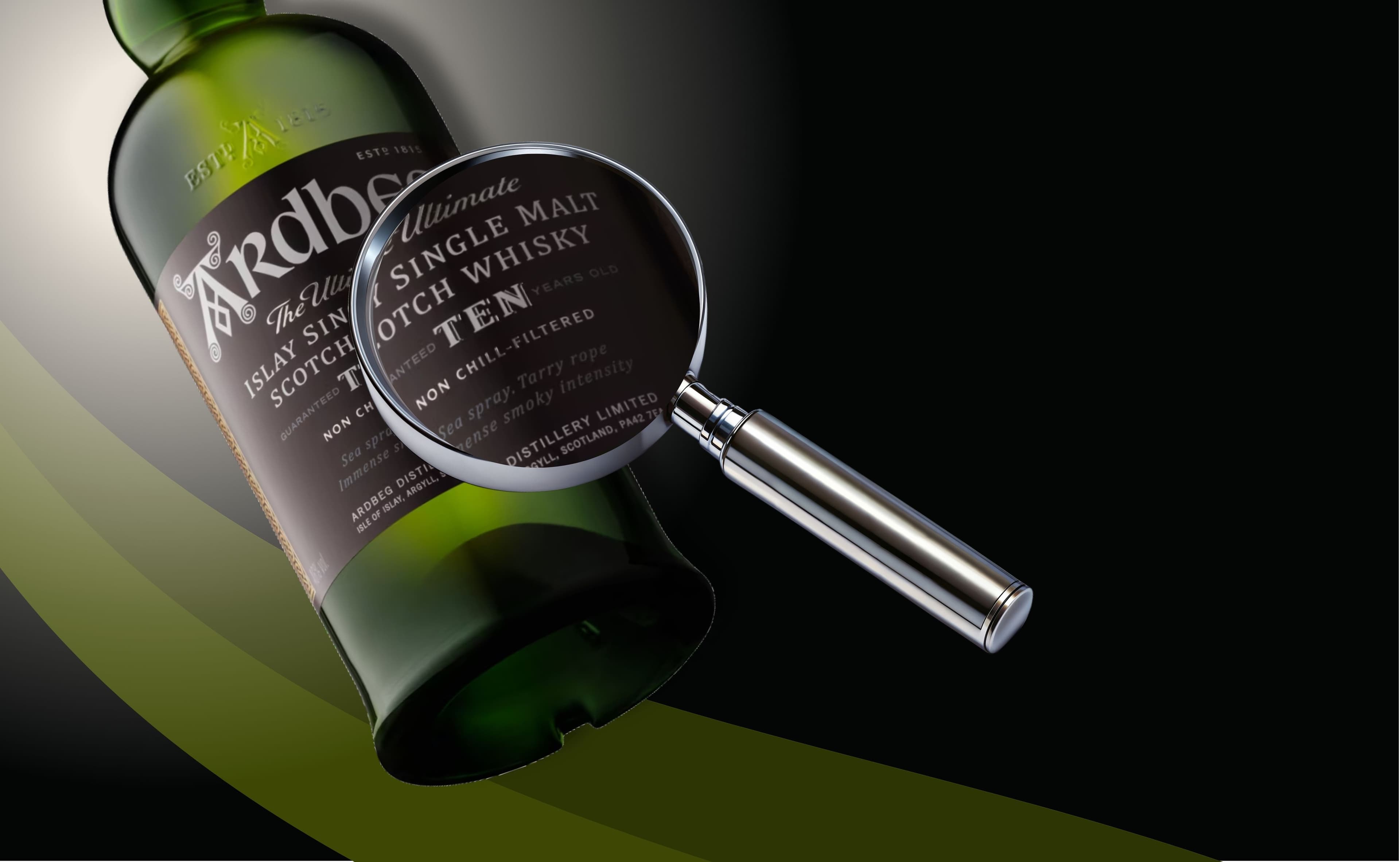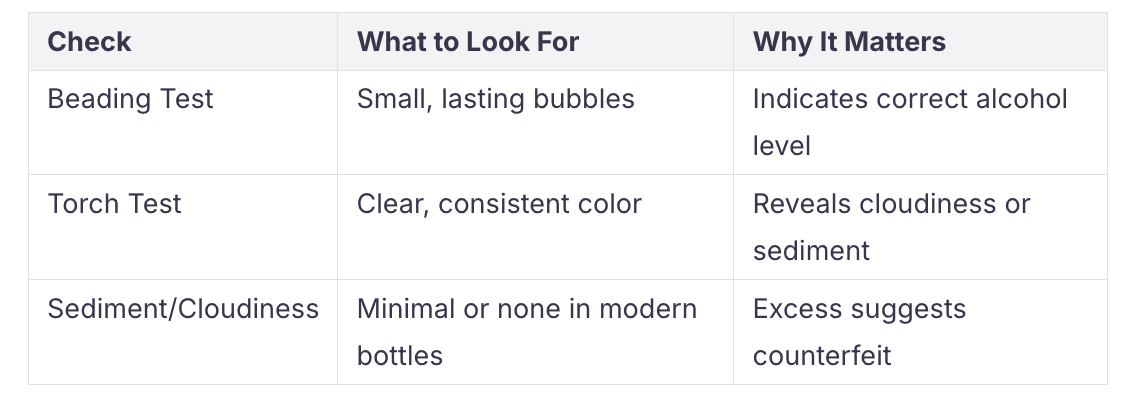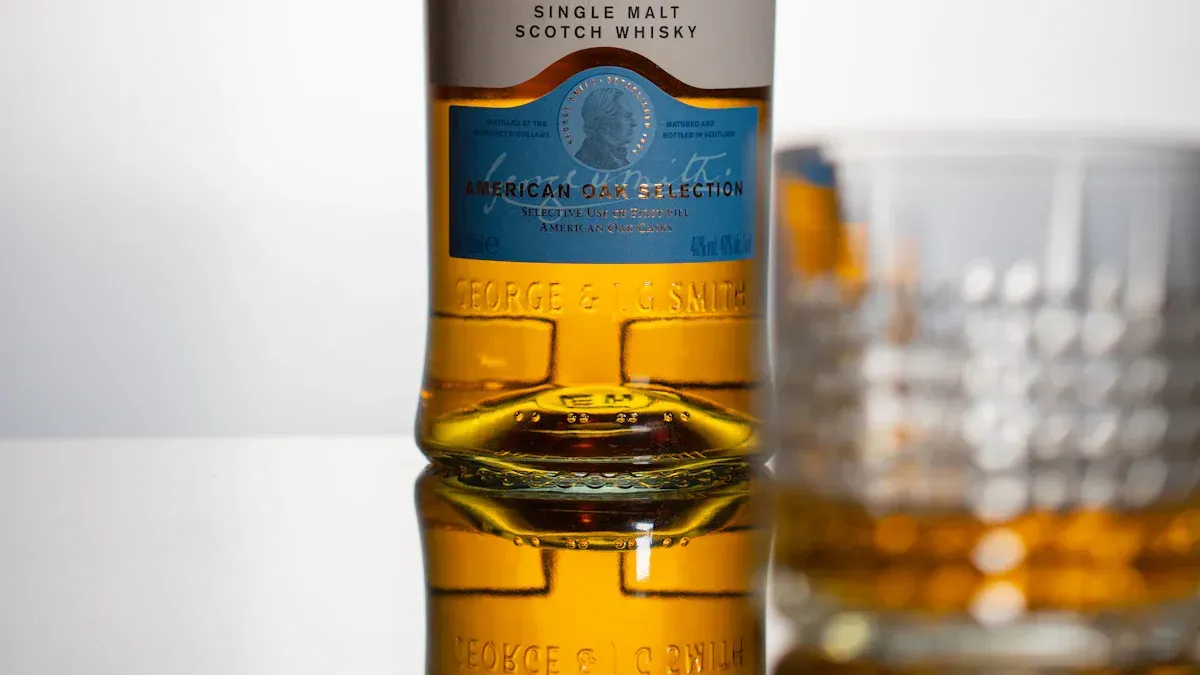26.07.2025
How to Spot Fake Whisky Bottles in your Collection

How to Spot Fake Whisky Bottles in your Collection
Spotting fake whisky bottles in your collection is possible when you know what to look for. Recent research by the Scottish Universities Environmental Research Centre found that 38% of old and rare Scotch whisky bottles tested from private collections were counterfeit. This high rate shows that fake whisky is a real concern for collectors. When you pay close attention to details like labels, packaging, and bottle features, you increase your chances to spot fake whisky bottles before they enter your collection. Stay alert and protect your whiskey investment.
Key Takeaways
-
Check labels and packaging carefully for spelling mistakes, poor print quality, and missing security features like holograms or QR codes.
-
Inspect the bottle and cap for signs of tampering, such as broken seals, uneven wax, or unusual bottle shape and markings.
-
Examine the whisky liquid by looking for clear color, consistent bubbles, and no sediment; smell the whisky if safe to do so.
-
Always verify the bottle’s history and buy from trusted sellers to avoid counterfeit whisky and protect your investment.
-
If you suspect a fake, do not drink it; report it to the brand or authorities and seek expert help to confirm authenticity.
How to Spot Fake Whisky Bottles
Counterfeit whisky bottles have become more sophisticated, making it essential for you to know how to spot fake whisky bottles in your collection. Careful, step-by-step inspection helps you catch even the most convincing fakes. Counterfeiters often substitute, duplicate, or tamper with genuine bottles and packaging. Some even refill empty bottles smuggled from other countries. You can protect your investment by learning to spot fake whisky bottles using these practical checks.
Labels & Packaging
Start your inspection with the label and packaging. Counterfeit bottles often show small but telling mistakes. Look for these signs:
-
Label Errors: Misspelled words, incorrect fonts, or inconsistent spacing can indicate a fake whisky. Compare the label to official images from the brand’s website.
-
Glue Residue: Genuine bottles use precise machinery for label application. Excess glue, crooked placement, or peeling edges suggest tampering.
-
Embossment and Print Quality: Run your fingers over the label. Authentic bottles often have raised lettering or high-quality printing. Faded ink or flat, cheap-feeling labels are red flags.
-
Packaging Flaws: Examine the box or tube. Poor-quality cardboard, blurry printing, or missing security features can signal a replica.
-
Security Features: Many brands now use holograms, barcodes, or QR codes on their packaging. Scan these codes with your phone to verify authenticity. Smart packaging technologies help you spot fake whisky bottles before they reach your shelf.
Tip: Keep the original packaging and compare it with any new purchases. Even small differences can help you spot a fake whisky.
Bottle & Cap
The bottle and cap offer more clues. Counterfeiters may reuse genuine bottles, but they rarely match every detail.
-
Cork, Wax Seal, and Capsule: Inspect the cork and any wax seal for signs of tampering. Look for uneven wax, broken seals, or capsules that do not fit snugly. Tamper-evident seals, like Bubble Tags, destroy themselves if removed, making any disturbance a warning sign.
-
Tax Strips and Holograms: Many countries require tax strips or hologram seals. These are difficult to replicate perfectly. Check for differences in engraving depth, seam position, or cut angle. Since 2022, some brands have added hologram seals to make counterfeiting harder.
-
Bottle Shape and Glass Quality: Compare the bottle’s shape and glass thickness with a known genuine bottle. Counterfeit bottles may have subtle differences in weight, clarity, or embossed numbers.
-
Embossed Numbers and Markings: Authentic bottles often have batch numbers or codes embossed into the glass. Fakes may have missing, faint, or poorly aligned markings.
A scientific study shows that damaged labels, broken seals, and tampered pourers provide valuable clues. While these checks do not guarantee authenticity, they help you spot fake whisky bottles and guide further investigation.
Note: Even if the bottle looks genuine, always check the seal. Counterfeiters sometimes refill real bottles with fake whisky, so seal inspection is necessary but not always enough.
Liquid Check
The liquid inside the bottle can reveal even more.
-
Beading Test: Gently shake the bottle and watch the bubbles. Authentic whisky forms small, long-lasting bubbles (beads) due to its alcohol content. If the bubbles disappear quickly or look unusual, you may have a fake whisky.
-
Color and Clarity: Hold the bottle up to the light or use a torch test. Genuine whisky usually has a clear, consistent color. Cloudiness, floating particles, or sediment can indicate poor-quality counterfeit whisky bottles.
-
Sediment and Cloudiness: Some older whiskies may have slight sediment, but most modern bottles should not. Excessive sediment or haze suggests a problem.
-
Smell: If you suspect a fake, open the bottle and smell the liquid. Off odors or a strong chemical scent are warning signs.

You can spot fake whisky bottles by combining these visual and physical checks. Counterfeit bottles often fail in one or more of these areas. Economic incentives drive the reuse and refilling of bottles, so control of packaging and bottle features is critical. Smart packaging and traceability systems now help brands and collectors track bottles from distillery to shelf, making it easier for you to spot a fake whisky.
Stay vigilant. Regular inspection and knowledge of these features will help you spot fake whisky and protect your collection from counterfeit bottles and replicas.
Spot Fake Whisky at Home

Authenticity Features
You can spot fake whisky bottles by checking for brand-specific security features. Many distilleries use holograms, QR codes, and tax labels to protect their products. These features help you confirm that you have a genuine bottle. For example, The Edrington Group uses tamper-evident 3D holographic labels on Macallan bottles. Some companies add QR codes or serial numbers that you can scan with your phone. These codes often link to official databases, letting you verify the bottle’s authenticity.
Law enforcement has uncovered cases where counterfeiters used both real and fake labels, capsules, and Italian tax strips to make bottles look genuine. This shows why you should always check these features closely. Holograms and tax strips are hard to copy. Systems like THESEUS™ and HoloTag use advanced technology to show if a bottle has been tampered with. When you see a missing or damaged security label, treat it as a warning sign.
Tip: Always scan QR codes or barcodes when possible. If the code does not match the brand’s records, you may have a fake whisky.
Provenance & Source
You should always verify where your bottle comes from. Provenance means the documented history of the bottle’s ownership and storage. A clear record helps you avoid counterfeit whisky and protects your investment. Guides on whisky appraisal stress that provenance supports accurate valuation and builds trust in the market.
Many rare bottles sold at auction have turned out to be fake. For example, a Macallan 1878 bottle sold for £8,000 was later found to be counterfeit. Researchers have also used scientific tests to tell real whisky from fakes. These cases show why you must trace the source and history of each bottle.
Buy from reputable sellers and ask for proof of origin. If a price seems too good to be true, it probably is. Careful checks and good records help you avoid fake whisky and keep your collection safe.
If You Suspect a Fake
Reporting Steps
If you suspect a fake whisky bottle in your collection, you should act quickly. Start by examining the bottle for common warning signs. Use a magnifying glass to check the label for spelling errors or pixelation. Inspect the tax strip on the neck for sticky patches or signs of removal. Assess the fill level; unusual levels may mean the bottle was refilled. Shake the bottle and watch the bubbles. Authentic whisky forms small, lasting beads. Feel the label edges for fresh adhesive, which can signal a label swap. Compare the bottle’s weight, shape, and cap details to official examples online.
If you still have doubts, report your concerns to the brand or local authorities. Many whisky producers have dedicated hotlines or email addresses for reporting suspected counterfeits. Provide clear photos and a detailed description of your findings. Your report helps protect other collectors and supports efforts to stop counterfeiters.
Expert Help
You can seek expert help to confirm a bottle’s authenticity. Professional labs use advanced techniques like gas chromatography-mass spectrometry to analyze the whisky’s chemical profile. These tests detect unique flavor compounds and age markers. Some experts use carbon dating or DNA fingerprinting to verify the origin and age of the whisky. Others rely on isotope ratio analysis or spectral analysis to match the bottle to known databases. Experienced tasters can also spot subtle differences in flavor.
Many distilleries now use tamper-proof seals, holograms, and blockchain records to help you verify bottles. If you remain unsure, contact a whisky authentication service or a reputable auction house for a professional opinion.
Health Risks
Never drink whisky if you suspect it is fake. Counterfeit bottles often contain toxic chemicals like methanol or ethylene glycol. These substances can cause blindness, organ failure, or death. In recent years, authorities have seized more fake alcohol than ever before. Countries around the world have reported hundreds of deaths from adulterated spirits. The World Health Organization estimates that a quarter of all alcohol consumed globally is illegally produced. Counterfeit whisky poses a serious health risk. Always prioritize your safety and avoid tasting any bottle you cannot verify.
You can spot fake whisky bottles by checking labels, packaging, bottle features, and the liquid inside. Regularly inspect your collection and always buy from trusted sellers. If you feel unsure, use these tips or ask an expert for help.
Stay alert—vigilance protects your collection from counterfeit whisky. Use your knowledge to keep your bottles safe and authentic.
FAQ
How can you tell if a whisky bottle is fake without opening it?
Check the label, cap, and packaging for errors or tampering. Scan QR codes or barcodes if available. Compare the bottle’s shape and markings to official images. Look for missing or damaged security features. If unsure contact Experts, for example at Spiritory.
What should you do if you accidentally buy a fake whisky bottle?
Contact the seller and report the issue. Reach out to the brand or local authorities with photos and details. Do not drink the whisky. Keep the bottle as evidence for any investigation.
Are older bottles more likely to be fake?
Yes, older bottles attract counterfeiters because they are valuable. Always check provenance and buy from trusted sources. Use expert authentication (for example from Spiritory) for rare or expensive bottles.
Can you use a smartphone to check whisky authenticity?
Yes, many brands use QR codes or holograms you can scan with your phone. These codes often link to official databases. If the code does not match, the bottle may be fake.
-
About the author

Majda Hübner
My journey with whisky truly began when I joined Spiritory in 2024. What started as a job quickly grew into a deep appreciation for the stories behind each bottle. From elegant Highland single malts to bold American rye, every expression has its own unique charm. Through the blog, I share discoveries, insights, and favorites hoping to inspire both newcomers and fellow enthusiasts alike. If you love whisky or are just starting to explore it, welcome - you’re in good blog.
